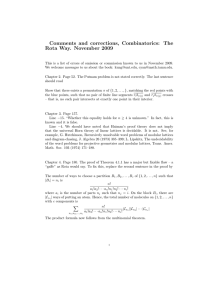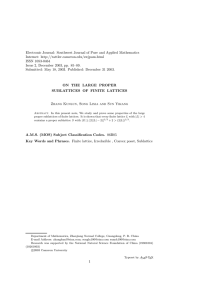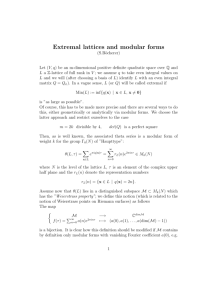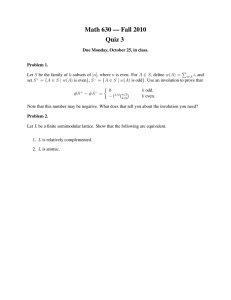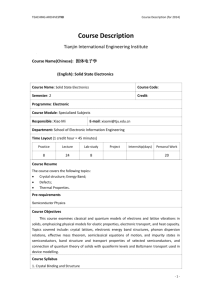COMPLEMENTS IN MODULAR AND SEMIMODULAR LATTICES
advertisement
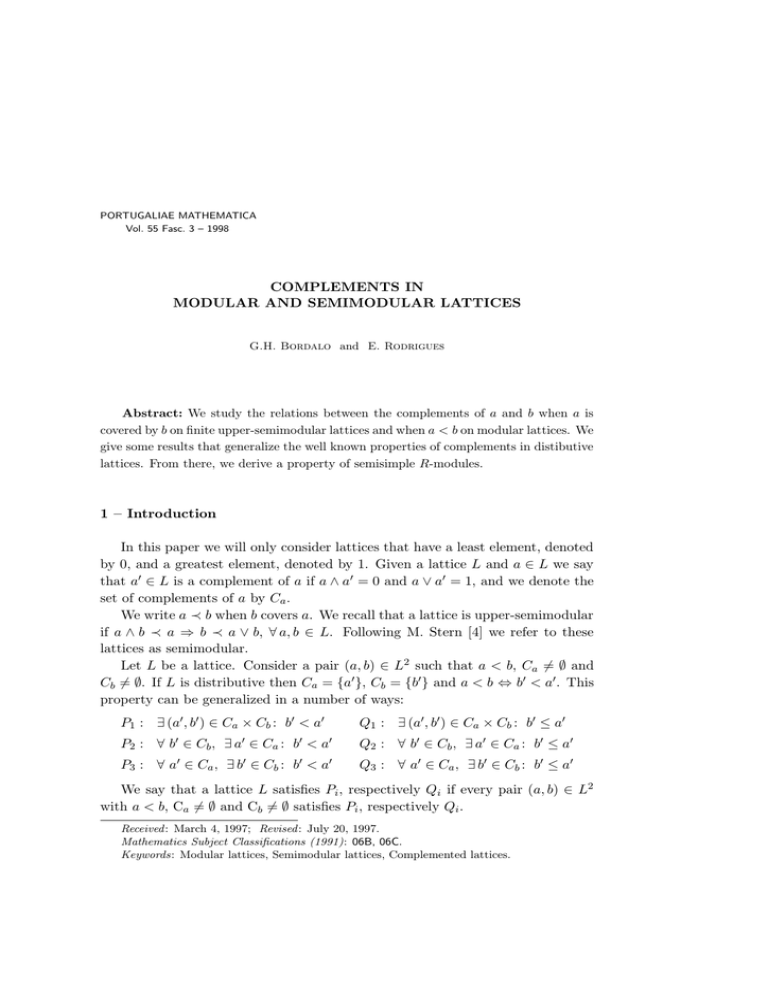
PORTUGALIAE MATHEMATICA
Vol. 55 Fasc. 3 – 1998
COMPLEMENTS IN
MODULAR AND SEMIMODULAR LATTICES
G.H. Bordalo and E. Rodrigues
Abstract: We study the relations between the complements of a and b when a is
covered by b on finite upper-semimodular lattices and when a < b on modular lattices. We
give some results that generalize the well known properties of complements in distibutive
lattices. From there, we derive a property of semisimple R-modules.
1 – Introduction
In this paper we will only consider lattices that have a least element, denoted
by 0, and a greatest element, denoted by 1. Given a lattice L and a ∈ L we say
that a0 ∈ L is a complement of a if a ∧ a0 = 0 and a ∨ a0 = 1, and we denote the
set of complements of a by Ca .
We write a ≺ b when b covers a. We recall that a lattice is upper-semimodular
if a ∧ b ≺ a ⇒ b ≺ a ∨ b, ∀ a, b ∈ L. Following M. Stern [4] we refer to these
lattices as semimodular.
Let L be a lattice. Consider a pair (a, b) ∈ L2 such that a < b, Ca 6= ∅ and
Cb 6= ∅. If L is distributive then Ca = {a0 }, Cb = {b0 } and a < b ⇔ b0 < a0 . This
property can be generalized in a number of ways:
P1 : ∃ (a0 , b0 ) ∈ Ca × Cb : b0 < a0
Q1 : ∃ (a0 , b0 ) ∈ Ca × Cb : b0 ≤ a0
P 2 : ∀ b 0 ∈ C b , ∃ a 0 ∈ C a : b0 < a 0
Q 2 : ∀ b 0 ∈ C b , ∃ a 0 ∈ C a : b0 ≤ a 0
P 3 : ∀ a 0 ∈ C a , ∃ b 0 ∈ C b : b0 < a 0
Q 3 : ∀ a 0 ∈ C a , ∃ b 0 ∈ C b : b0 ≤ a 0
We say that a lattice L satisfies Pi , respectively Qi if every pair (a, b) ∈ L2
with a < b, Ca 6= ∅ and Cb 6= ∅ satisfies Pi , respectively Qi .
Received : March 4, 1997; Revised : July 20, 1997.
Mathematics Subject Classifications (1991): 06B, 06C.
Keywords: Modular lattices, Semimodular lattices, Complemented lattices.
374
G.H. BORDALO and E. RODRIGUES
If L is a finite modular lattice, we note that Q2 is a restriction of the well
known order between the ideals of a finite poset (see also P. Ribenboim [2]).
Given a pair (a, b) ∈ L2 such that a < b, Ca 6= ∅ and Cb 6= ∅, the implications
P2 ⇒ P1 , P3 ⇒ P1 , Q2 ⇒ Q1 , Q3 ⇒ Q1 and Pi ⇒ Qi , i = 1, 2, 3 are valid, for
this pair. As they are valid for every pair, they are also valid for lattices. These
implications are ilustrated in the next picture.
Fig. 1
There are finite complemented lattices where not even Q1 is satisfied. Here is
an example:
Fig. 2
L1 is a complemented finite lattice and satisfies the Jordan–Dedekind chain
condition. We note that L1 is not semimodular.
Let us now consider the following lattice:
Fig. 3
COMPLEMENTS IN MODULAR AND SEMIMODULAR LATTICES
375
L2 is a finite, complemented lattice which is also semimodular. The pair (a, b)
satisfies neither Q3 nor P2 . However, every pair satisfies Q2 . We will prove that
finite semimodular complemented lattices, in particular partition lattices, satisfy
Q2 , and that all modular lattices satisfy P2 and P3 . We will also prove that
modular complemented lattices satisfy the following property:
P :
∀ a 6= b ∈ L,
if Ca 6= ∅ and Cb 6= ∅
then Ca 6= Cb .
The lattice L2 does not satisfy P . In fact i 6= h and Ci = Ch = {e, c, a, b}.
It is easy to see that the properties Pi , Qi , i = 1, 2, 3, and P are preserved
under direct products, that is, if, ∀ i ∈ I, Li satisfies one of these properties, then
Q
i∈I Li also satisfies that property.
2 – Finite semimodular lattices
We start with more general results concerning semimodular lattices.
Lemma 1. Let L be a finite semimodular lattice, a, b ∈ L, a ≺ b, b0 ∈ Cb \Ca .
i) (a ∨ b0 ) ∧ b = a and a ∨ b0 is a co-atom.
ii) If there exists c ∈ L such that b0 ≺ c and a ∨ c = 1 then c ∈ Ca .
iii) If there exists an atom a1 ∈ L such that a1 ∨ (a ∨ b0 ) = 1 then, a1 ∨ b0 is a
complement of a and b0 ≺ a1 ∨ b0 .
b0
Proof: Let L be a finite semimodular lattice and a, b ∈ L, a ≺ b, and let
∈ Cb \Ca .
i) We have a∧b0 = 0 and b0 ∈
/ Ca therefore a∨b0 < 1. Since (a∨b0 )∨b = 1 we
0
have (a∨b )∧b < b. From a ≤ (a∨b0 )∧b < b and a ≺ b we conclude a = (a∨b0 )∧b.
As L is semimodular a = (a ∨ b0 ) ∧ b ≺ b implies a ∨ b0 ≺ a ∨ b0 ∨ b = 1.
ii) If a ∧ c > 0 then there is a1 such that 0 ≺ a1 ≤ a ∧ c. Also a1 ≤ a < b so
a1 ∧ b0 = 0 and as 0 ≺ a1 then b0 ≺ a1 ∨ b0 . On the other hand a1 < c and b0 ≺ c
imply a1 ∨ b0 ≤ c so c = a1 ∨ b0 . We conclude a ∨ b0 = (a ∨ a1 ) ∨ b0 = a ∨ (a1 ∨ b0 ) =
a ∨ c = 1. But from a < b and b ∧ b0 = 0 we get a ∧ b0 = 0 so b0 ∈ Ca , which is a
contradiction.
iii) We have a ∧ b0 = 0 and b0 ∈
/ Ca so a ∨ b0 < 1. From a1 ∨ (a ∨ b0 ) = 1 we
have a1 6≤ a ∨ b0 , and so a1 ∧ (a ∨ b0 ) = 0. This implies a1 ∧ b0 = 0 so, by the
semimodular property, b0 ≺ a1 ∨ b0 . Now by using ii) we conclude a1 ∨ b0 ∈ Ca .
376
G.H. BORDALO and E. RODRIGUES
Theorem 2. Let L be a finite semimodular lattice, a, b ∈ L such that a ≺ b
and Cb 6= ∅. If Ca 6⊆ Cb then ∀ b0 ∈ Cb \Ca , ∃ c ∈ Ca : b0 ≺ c.
Proof: Let L be as stated, and let a, b ∈ L, a ≺ b and a0 ∈ Ca \Cb . Let
∈ Cb \Ca . We have a0 ∨ b = 1 and a0 ∈
/ Cb so 0 < a0 ∧ b. Let a1 be an atom
such that a1 ≤ a0 ∧ b. From a ∧ a0 = 0 and a1 ≤ a0 we have a ∧ a1 = 0, and, as
0 ≺ a1 and L is semimodular we conclude a ≺ a ∨ a1 . Since a < b and a1 ≤ b we
get a ∨ a1 ≤ b, and, as a ≺ b, we have a ∨ a1 = b.
b0
Let c := a1 ∨ b0 . Then a ∨ c = a ∨ (a1 ∨ b0 ) = (a ∨ a1 ) ∨ b0 = b ∨ b0 = 1. By the
third part of Lemma 1, we conclude c ∈ Ca .
Corollary 3. Let L be a finite semimodular lattice. If a, b ∈ L are such that
a ≺ b, Cb 6= ∅ and Ca 6⊆ Cb then (a, b) satisfies Q2 .
Proof: Let L, a, b ∈ L be as stated. Let b0 ∈ Cb . If b0 ∈ Cb \Ca then by the
theorem ∃ a0 ∈ Ca : b0 ≺ a0 in particular b0 ≤ a0 . If b0 ∈ Ca then take a0 = b0 .
Corollary 4.
i) Finite complemented semimodular lattices satisfy Q2 .
ii) Let L be a finite semimodular lattice, a, b ∈ L such that Ca 6= ∅, Cb 6= ∅
and a ≺ b. Then (a, b) satisfies Q1 .
Proof: i) Let L be a finite complemented semimodular lattice and (a, b) ∈ L2 .
First we note that on a finite complemented lattice if we show that Q2 holds when
a ≺ b then this property is also valid when a < b. Let a ≺ b. The property holds
when b0 ∈ Ca . Supose b0 ∈ Cb \Ca . By the first part of Lemma 1, the element
a ∨ b0 is a co-atom. It is easy to see that there is a complement, a1 , of a ∨ b0 which
is an atom. So, by Lemma 1, iii), b0 ≺ b0 ∨ a1 and Q2 is satisfied.
ii) Let L and a, b ∈ L be as stated. If Ca 6⊆ Cb then, by Corollary 3, (a, b)
satisfies Q2 and therefore satisfies Q1 . If Ca ⊆ Cb then choose a0 ∈ Ca and
consider the pair (a0 , a0 ) ∈ Ca × Cb .
There are finite semimodular lattices which do not satisfy Q2 . Here is an
example:
COMPLEMENTS IN MODULAR AND SEMIMODULAR LATTICES
377
Fig. 4
3 – The case of modular lattices
Note that, given a modular lattice L, and a, b ∈ L, if Ca 6= ∅ and Cb 6= ∅ then
Ca and Cb are antichains. The next theorem tells us how they are related.
Theorem 5. Modular lattices satisfy P2 and P3 .
Proof: It is enough to show P2 because this implies P3 by duality. Let L be
a modular lattice. Consider a, b ∈ L such that a < b, Ca 6= ∅ and Cb 6= ∅. For all
b0 ∈ Cb choose a0 ∈ Ca . We will prove that a00 := (a0 ∧ b) ∨ b0 is a complement of a
greater than b0 . In fact, a ∨ a00 = (a ∨ (a0 ∧ b)) ∨ b0 = ((a ∨ a0 ) ∧ b) ∨ b0 = b ∨ b0 = 1.
Also, a∧((a0 ∧b)∨b0 ) = a∧(((a0 ∧b)∨b0 )∧b) = a∧((a0 ∧b)∨(b0 ∧b)) = a∧a0 ∧b = 0.
We have b0 ≤ a00 and if b0 = a00 then we would have a < b, a ∧ b0 = b ∧ b0 = 0 and
a ∨ b0 = b ∨ b0 = 1, which contradicts the modularity of L.
Corollary 6. In a complemented modular lattice, for each ascending chain
0 < a1 < · · · < a n < · · · < 1
there exists a descending chain
1 > a01 > · · · > a0n > · · · > 0
such that a0i is a complement of ai in L.
The following example shows that modular lattices do not have to satisfy P .
378
G.H. BORDALO and E. RODRIGUES
Fig. 5
In fact, we have a 6= b and Ca = Cb 6= ∅. We note that a ∨ b does not have
a complement. We will see that, in a modular lattice, if a ∨ b and a ∧ b have
complements, then P holds.
Theorem 7. In a modular lattice L, if the set of complemented elements
forms a sublattice, then L satisfies P .
Proof: Let L be a modular lattice, and let a 6= b ∈ L. Supose a and b have
complements. If a < b then, let b0 ∈ Cb . We know, by Theorem 5, that there is
a0 ∈ Ca such that b0 < a0 . Therefore a0 ∈
/ Cb . Supose that {a, b} is an antichain.
We will show that, if a ∨ b and a ∧ b have complements, then Ca 6= Cb .
Let c and d be complements of a ∨ b and a ∧ b, respectively, such that c < d.
We have:
c ∧ (a ∨ b) = 0; c ∨ (a ∨ b) = 1; d ∧ (a ∧ b) = 0; d ∨ (a ∧ b) = 1 .
We will show that (b ∧ d) ∨ c ∈ Ca \Cb :
³
´
(b ∧ d) ∨ c ∨ a = (a ∧ b) ∨ (b ∧ d) ∨ c ∨ a =
³
´
(b∧d)∨c ∧a =
µ³
µ³
¶
´
¶
´
(a ∧ b) ∨ d ∧ b ∨ c ∨ a = b ∨ c ∨ a = 1 ;
µ
³
(b∧d)∨c ∧(a∨b) ∧a = (b∧d)∨ c∧(a∨b)
³
´
(b ∧ d) ∨ c ∨ b = (a ∧ b) ∨ (b ∧ d) ∨ c ∨ b =
µ³
´
´¶
∧a = b∧d∧a = 0 ;
¶
(a ∧ b) ∨ d ∧ b ∨ c ∨ b = b ∨ c < 1 ,
because L is modular.
As an immediate consequence we have the following theorem:
Corollary 8. Modular complemented lattices satisfy the property P .
Corollary 9. In a modular lattice, if two elements a and b are such that
a ∨ b and a ∧ b are complemented, then a and b also are complemented.
COMPLEMENTS IN MODULAR AND SEMIMODULAR LATTICES
379
Proof: The case of a and b being comparable, is trivial. If a and b are
not comparable, let c and d be complements of a ∨ b and a ∧ b, respectively,
such that c < d. From the proof of Theorem 7 we get (b ∧ d) ∨ c ∈ Ca \Cb and
(a ∧ d) ∨ c ∈ Cb \Ca .
We conclude with an application of Corollary 6 to the theory of R-modules
over a ring:
Corollary 10.
cending chain
In a semisimple R-module, M , there exists an infinite as{0} ⊂ M1 ⊂ · · · ⊂ Mn ⊂ · · ·
if and only if there exists an infinite descending chain
M ⊃ M10 ⊃ · · · ⊃ Mn0 ⊃ · · ·
such that M is the direct sum of Mi0 and Mi .
Proof: Note that the lattice of submodules of a semisimple R-module is
modular and complemented. If we have an infinite ascending chain {0} ⊂ M1 ⊂
M2 ⊂ · · · ⊂ Mn ⊂ · · · of submodules of M then, by Corollary 6, we can build an
infinite descending chain M ⊃ M10 ⊃ M20 ⊃ · · · ⊃ Mn0 ⊃ · · ·, therefore M is not
artinian.
The proof of the other implication is analogous, using the dual of Corollary 6.
From this corollary, it follows the well known result that a semisimple
R-module, M , is noetherian if and only if it is artinian.
ACKNOWLEDGEMENT – We acknowledge with thanks useful comments by Joel Berman.
REFERENCES
[1] Crawley, P. and Dilworth, R. – Algebraic Theory of Lattices, Prentice-Hall,
Englewood Clifs, New Jersey, 1973, ISBN 0-13-022269-0.
[2] Ribenboim, P. – Ordering the set of antichains of an ordered set, Collect. Math.,
46(1-2) (1995), 159–170.
[3] Salii, V.N. – Lattices With Unique Complements, AMS, 1988, ISBN 0-8218-4522-5.
[4] Stern, M. – Semimodular Lattices, Teubner-Text zur Mathematik, StuttgartLeipzig, 1991, ISBN 3-8154-2018-0.
380
G.H. BORDALO and E. RODRIGUES
Gabriela Hauser Bordalo,
Centro de Álgebra da Universidade de Lisboa (C.A.U.L.),
Av. Professor Gama Pinto, 2, 1699 Lisboa Codex – PORTUGAL
E-mail: mchauser@ptmat.lmc.fc.ul.pt
and
Elias Rodrigues,
Univ. da Madeira, Departamento de Matemática,
Colégio dos Jesuitas, Largo do Municı́pio, 9000 Funchal – PORTUGAL
E-mail: elias@dragoeiro.uma.pt
